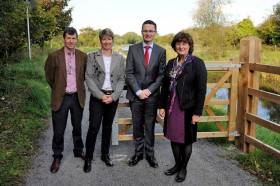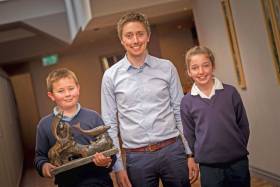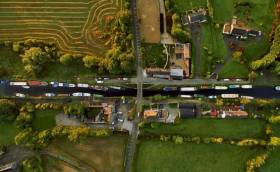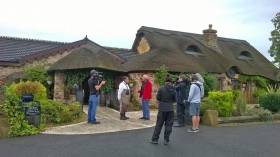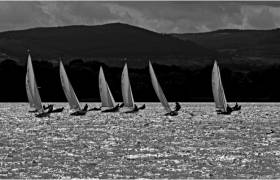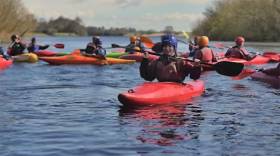Displaying items by tag: inland waters
Bobby Kerr’s Travels Along Home Shores Begin This Thursday
#OnTV - The first episode of Bobby Kerr-fronted UTV Ireland series Along Home Shores comes this Thursday 27 October at 7.30pm and explores Dublin’s waterways, with a visit to the famous wallabies of Lambay Island.
Afloat.ie reported last month on filming for the new eight-part-TV series, in which the Insomnia café entrepreneur and avid sailor will discover the hidden treasures of the coastlines and waterways of Ireland.
In each episode, Bobby will examine how people are using the natural resources of our waterways to create employment, while also showcasing the beauty of Ireland along the way. Over eight weeks, he will embrace the heart of maritime communities all over Ireland.
The first episode sees Bobby beginning his journey on his own doorstep of Dublin, where he goes for an early morning swim at the Forty Foot with members of the Sandycove Bathers Association.
At Grand Canal Dock, he meets a local leisure business and tries paddle boarding for the first time, and Bobby's fitness is put to the test when cancer support group, the Plurabelle Paddlers, bring him dragon boat training.
Eugene Garrihy, the owner of Dublin Bay Cruises, invites Bobby on board his boat to talk business, and he also gets an exclusive invite to the hidden gem of Lambay Island by businessman Michael Bermingham, who is the only supplier of Lambay meat in Ireland.
"I have been truly amazed by the scenic beauty of Ireland's coastline and inland waterways during my filming of Along Home Shores,” said Bobby of his experience making the series.
“The fascinating characters I met along the way were an absolute inspiration to me. Through the prisms of heritage, business and culture, I have now gained a unique insight into Ireland. The sheer magnificence of our coastal and inland waterways, and their people, cannot be overstated."
Beginning his voyage in the capital, Bobby will bring the personality of coastal towns, villages and inland waterways to life as he travels anticlockwise around Ireland before ending his journey back in Dublin.
Future weeks will see him visiting Rathlin Island's seabird colony, kayaking the Causeway Coast, angling on Lough Erne, sailing on Lough Derg, attending the homecoming of Skibbereen's Olympic heroes, cycling the Deise Greenway, going oyster farming, staying overnight in a lighthouse and lots more.
The first episode of Along Home Shores airs this Thursday 27 October at 7.30pm on UTV Ireland.
New Royal Canal Greenway Section Opened In Westmeath
#InlandWaters - The extension of the Royal Canal Greenway in Westmeath from Coolnahay Harbour to the Longford county boundary was officially opened last week.
The new greenway, a 14.4km cycle way, links with the 32.6km already provided along the waterway under an earlier scheme.
Minister of State for Tourism and Sport Patrick O'Donovan joined Cllr Frank McDermott, Cathaoirleach of Westmeath County Council and Waterways Ireland chief executive Dawn Livingstone to officially opened this phase of the cycle way on Friday 7 October.
The aim of the project is to increase the number of walkers and cyclers to the Royal Canal, whether commuting along the Greenway or for recreational purposes.
The project, made possible with funding granted in 2013 and a licence from Waterways Ireland, involved upgrading works and surface dressing on certain sections of the Royal Canal along with informative signage, seating and cycle-friendly gates.
The new cycle path is already in use by both pedestrians and cyclists and is reportedly proving a popular recreational facility in the area.
Salmon Life Cycle Video Nets ‘Something Fishy’ Prize For Sligo Pupils
#SomethingFishy - Pupils at Scoil Chroí Naofa in Bunninadden, Sligo have been named the national winners of Inland Fisheries Ireland’s Something Fishy competition for 2016 at an event in Sligo’s Clarion Hotel yesterday (Wednesday 12 October).
The winning group of 24 children from the school’s senior class take home the National Something Fishy Award and €700 for their animated short on the life cycle of the salmon – selected by an independent judging panel comprising fisheries officers and education staff.
Along with their teacher Adrian Ormsby, the class edited and produced the digital and artistic photo story during the previous school term.
The ‘Something Fishy’ programme is an educational initiative of Inland Fisheries Ireland (IFI) in partnership with Blackrock Education Centre, which allows students to learn about fish and the environment in a local context.
The 2016 programme saw 3,776 children taking part in 118 schools and 11 education centres nationwide. Students were invited to submit project entries into the competition with this year’s entries addressing the theme ‘Focus on Learning’.
“The standard of entry to this year’s Something Fishy competition was particularly high and it is fantastic to have so many children engaged on our fisheries resource,” said IFI chief executive Dr Ciaran Byrne.
“Something Fishy gives children an opportunity to learn valuable lessons about the importance of protecting and conserving the aquatic environment but perhaps more importantly, they are also empowered to share their learnings with their peers via digital projects which can be enjoyed by all.”
Bernie Burke, principal of Scoil Chroí Naofa, described the win as “a fantastic achievement by the students involved who have thoroughly enjoyed taking part in the programme.
“They have discovered the magical world within our waterways and enjoyed learning all about the aquatic environment. I would like to congratulate each of them and their teacher Mr Ormsby on all their hard work.”
Since the inception of Something Fishy in 2005, some 50,000 children have participated in the initiative which aims to promote interest and understanding in fish and their habitats.
As part of the educational programme, IFI fisheries officers visit schools and provide classroom-based assistance, with a full range of resources for teachers and children also available on the Something Fishy website.
Together, they explore the themes of fish, habitats, angling, water environment and the protection and conservation of Ireland’s rivers and lakes.
Aside from school-based learning, fisheries officers take students into the field to give them some practical experience of their work.
#InlandWaters - Waterways Ireland completed the first week of its pilot 'Water Project' for post-primary schools last Friday 30 September.
Ninety students and teachers from four second-level schools in Co Fermanagh are engaged in water-based learning activities on Lough Erne as part of the two-week pilot educational project which concludes tomorrow (Friday 7 October).
Pupils and teachers from St Fanchea's College, St Aidan's High School, Devenish College and St Joseph's College undertook the two-day programme at Waterways Ireland's headquarters in Enniskillen, where they took part in biodiversity workshops and discovered some of the many fascinating water-based creatures, birds and aquatic plants that exist along the shoreline of Lough Erne.
They also rowed a 33ft currach in the Bronze Age style, and learned the techniques of angling, before diving into kayaking and a heritage workshop in Fermanagh Castle Museum earlier this week.
Initial feedback from both students and teachers has been positive, according to Waterways Ireland, which adds that at the end of the two-week pilot all feedback from partners and participants will be gathered to inform an evaluation report and future development of the project in the months ahead.
The Water Project has been developed and implemented in partnership with Row the Erne; Erne Paddlers; Inland Fisheries (DAERA) and the National Coarse Fishing Federation of Ireland; Fermanagh Castle Museum; RSPB and the Ulster Wildlife Trust.
Waterways Ireland has ongoing educational work with primary schools centred on the waterways. The Water Project aims to promote awareness and knowledge of the importance of Lough Erne and access to its many recreational activity opportunities for secondary students.
‘Boatel’ Among New Businesses On Ireland’s Inland Waterways
#InlandWaters - Waterways Ireland was on hand to welcome Mary McInerney and Jorgen Bjerknes’ new ‘boatel’ on arrival in Enniskillen earlier this week as part of their tour of the Erne System.
Based between Carrick-on-Shannon and Enniskillen, the married couple launched their converted barge Lovely Leitrim – which also operates as a private party venue and pop-up restaurant – in April this year, according to The Irish Times.
Lovely Leitrim is one of eight new businesses supported and licensed by Waterways Ireland in the past 12 months, a number that includes Water Taxi NI and Erne Boat Hire on the same waterways.
The other six start-ups are based on the River Shannon, the Shannon Erne Waterway and the Grand Canal.
Speaking on Monday 26 September, Waterways Ireland head of property Sinead Mallon said: “It's great to have welcomed two new businesses on the Erne system this year and we look forward to hearing from other entrepreneurs with their business ideas.”
Waterways Ireland invites people with new business ideas or existing business who wish to consider relocating to the Erne System to start discussions with the property and legal team by completing a Commercial Operating Licence form available online at www.waterwaysireland.org
Waterways Ireland Wins Heritage Award At World Canals Conference
#InlandWaters - Waterways Ireland has won the Guardian Award at the 2016 World Canals Conference for its Traditional Heritage Boat Survey of the Royal Canal, Grand Canal, Barrow Line Canal and Barrow Navigation.
Undertaken as part of the Waterways Ireland Heritage Plan launched earlier this year, the project was led by environment officer Cormac McCarthy, who attended the event in Scotland to receive the presentation.
The World Canals Conference took place Monday 19 to Thursday 22 September in Inverness, welcoming international waterway experts, business leaders and global professionals to join in celebrating and exploring innovation in sustainable tourism, regeneration, engineering and heritage management of our waterways and much more.
The Guardian Award is sponsored by Historic Environment Scotland and celebrates outstanding work to safeguard the heritage of the world's waterways.
In other inland waterways news, Two Cooks Restaurant & Wine Bar in Sallins, Co Kildare, on the banks of the Grand Canal, took the Taste of the Waterways Award for 2017 at the Georgina Campbell Awards.
The winning eatery – opened recently by Josef Zammit and Nicola Curran, a well known couple with a following among Kildare diners – is one of many featured in A Taste of the Waterways, the annual guide produced by Waterways Ireland in conjunction with Georgina Campbell.
Other waterfront winners at the latest ceremony include Viewmount House in Longford, along the Royal Canal, which was named Country House of the Year, and Country Choice in Neagh, Co Tipperary, a popular rest stop on for Shannon boaters, which won the award For Services to Irish Food & Hospitality.
New TV Series To Highlight Lives On Ireland's Waters
#OnTV - Filming has commenced for the new UTV Ireland programme Along Home Shores.
The eight-part TV series is focusing on the waterways of Ireland, with each show examining inland, coastal and offshore lives in a different region of the country.
Taking the helm is Newstalk presenter Bobby Kerr, best known for his coffee chain Insomnia and his role as an investor on Dragon's Den.
As he travels the country, Kerr is meeting locals and businesses who live, play and work on the waterways.
So far the crew have made their way along the Lower Bann, the Grand Canal, Lough Erne and more recently along the Shannon, stopping in Carrick-on-Shannon and Lough Key Forest Park in Boyle.
The eight-part series will air Monday nights on UTV Ireland later this autumn.
IDRA 14 National Championships 2016 At Lough Derg Yacht Club
There were ideal saiing conditions at Lough Derg Yacht Club for the 22 boats competing at this year's IDRA 14 dinghy national championships writes Philip Hackett.
I set off for this year’s nationals thinking that a fairly sedate affair was in store; light winds set to weaken and lots of 70th anniversary yarns to sit through...fool me. The unexpected moderate winds and sunny spells made for ideal conditions in a superb location. That combined with the excellent facilities and hospitality afforded to us by LDYC made this one of the best nationals for our class in my experience.
New build IDRA 14 #166 Wicked Sadie
A quiet few days on the Shannon away from the crowds?.... The start line was worse than the M50 on a Friday bank holiday weekend and far more exciting. All very bad for the blood pressure but the starts really helped to mix up the fleet and gave some people a taste of glory up front for a while (Gordon and Mark race 6) and made the front runners work hard for points, having to battle up from the back of the fleet in several races. That all helped to make this event very competitive with a tight fleet and lots of tussles, front, middle and rear. The exception being the #1 spot with Alan Henry and Simon Revill (#134 Dubious) dominating the front without any serious challenge until they got snarled up on the start line on the final race. A little more on that later.
134 Dubious ….sometimes it's lonely at the top
The first day ended following a double win for #134. Pat O’Neill/Oisín O’Conor (#15 Delos II) tied for second position with Alan Carr/Ian MC Cormack (#38 Starfish) and third position also tied between myself/Fiachra Collins (#163 Chance), Frank Hamilton/Marjo Moonen (#140 Dunmoanin) and Andy Sargent/Callum Maher (#4 Dusk) and several others in close position thereafter.
The second day saw 134 again with a double win and second position still tied between Alan Carr/38 and Pat O’Neill/15. Pierre Long/John Parker(#161 Dart) moved up into 4th place behind them. The second race on this day had to be restarted due to the leeward mark drifting….post race chat revealed that most people reckoned the race was theirs if only it hadn't been restarted….indeed. Other notable events of the day saw Jim Lambkin/Wendy Rudd(#1 Error) mistakenly returning to the line for someone else's individual recall and Pat O’Neill receiving a schelp from our boom following an inadvertent jibe on the start line (sorry again Pat).
Pat O’Neill and Alan Carr….stern chasing
The final day was showdown time for second place between Alan Carr and Pat O’Neil but both were badly hemmed in on the start line in the first race and they finished 5th and 6th respectively. Second place went to Frank Hamilton/140 and third to Pierre Long/161. Running into the final race Alan Henry/134’s winning streak remained unbroken and just one point separated Alan Carr ahead of Pat O’Neil. The Committee Boat end of the line had been particularly busy in several of the previous races and so several people decided that the pin end would be the smart place to be…...however the pin end in this final race turned out to be the veritable eye of the needle….several of the leading contenders either coming into contact with each other or the the mark or else stalling in the general melee. Myself and Fiachra managed to stay clear of it and crossed the start line with good speed and time. We kept our clear lead for the rest of the race. Gordon Kelly/Mark Masterson(#129 Del) had a lengthy taste of potential glory holding a good second position for most of the race until suffering a capsize at the end of the final reach. Pat O’Neill started at the very back of the fleet and #134 helmed by Simon Revill with Alan Henry now crewing also trailed the fleet at the start. However both these boats battled their way up through most of the fleet with Pat finally finishing 4th and Simon 2nd. Alan Carr also worked hard to make his way up and finished in 7th. Another very notable result being that of 3rd place taken by Catherine Martin/Brian Murphy(#122 Diane). Catherine is new to the class and had little prior experience of spinnaker sailing.
The final results saw Alan Henry/Simon Revill take 1st, Pat O’Neill/Oisín O’Connor 2nd and Alan Carr/Ian McCormack 3rd.
One very welcome innovation at this year’s Nationals being a rescue boat with a sun deck and onboard bar facilities…..Donal Heney/Louise Coulter(#71 Atomic) being taken in tow and aboard by a spectating motor cruiser. Ageing boy scouts John Lynch/Stephen Harrison(#158 Stoked) lived up to the motto Be Prepared by having a spare tiller to hand when they also suffered similar equipment failure.
The number of family members, over a 3 generation spread, racing with or against each other was also very notable this year...with the youngest competitor, SDC’s Caoimhe Fleming, aged 14 and the oldest being in his mid sixties. There was also a big contingent of younger sailors from CYBC’s junior section attending the event with four boats either being crewed or helmed by them, Pat O’Neill’s crew, Oisín O’Connor, being one of these.
A thoroughly enjoyable and successful event. I am looking forward to returning to Lough Derg again soon.
Lough Derg Yacht Club..Race Officer John Leech with the IDRA 14 fleet
Waterways Ireland To Open Archive For European Heritage Open Days
#InlandWaters - Waterways Ireland will be throwing open the WI Archive to the public on Saturday 10 and Sunday 11 September to celebrate European Heritage Open Days 2016.
Waterways Ireland HQ in Enniskillen will be open between 12pm and 5pm both days next weekend for free guided tours of the archives and building.
All are welcome to pop in for a visit and discover some of the interesting engineering maps, drawings and images of the waterways from the past 150 years.
To find out more email [email protected] or visit the Discover Northern Ireland website to download a brochure on all the special heritage events next weekend.
Last Chance To Join In Blueway 10k Challenge This Weekend
#Blueway10k - Places are still open for experienced kayakers to sign up for this weekend's Blueway 10k Challenge, as the Nenagh Guardian reports.
Organised by Canoeing Ireland and the Canoe Association of Northern Ireland with Waterways Ireland, the nine events taking place simultaneously across the island this Saturday 20 August will see novice paddlers put their skills developed over the last 12 weeks of training to the test.
As previously reported on Afloat.ie, the initiative aims to take the hassle out of kayaking or canoeing on Ireland's inland waterways, showing that access to watersports is quicker and easier than many people think.
Three-time Irish Olympian Eoin Rheinisch gives an overview of the final week of training ahead of this weekend's challenge:



























